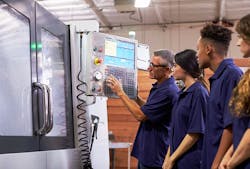The National Science Board (NSB, Board) released its policy companion statement to Science and Engineering Indicators 2018, “Our nation’s future competitiveness relies on building a STEM-capable U.S. workforce.”
The NSB’s statement underscores the Board’s view that growing the nation’s science, technology, engineering, and mathematics (STEM) workforce is essential for our economy and global competitiveness. It offers recommendations for strengthening a diverse STEM-capable U.S. workforce inclusive of all levels of education.
“STEM knowledge and skills are vital for our nation’s businesses to compete in today’s world, and for bringing better jobs and greater prosperity to every region of our country,” said Victor McCrary, NSB member and vice president for Research and Economic Development at Morgan State University. “Businesses large and small across the U.S. need adaptable, STEM-capable workers at every education level and from all demographic groups in order to be competitive. Creating a strong, diverse STEM-ready workforce is essential to economic and social prosperity, and we all have a role to play in this critical effort.”
According to the National Survey of College Graduates, the number of U.S. jobs that require substantial expertise in STEM increased nearly 34% over the past decade. While the number of Americans with a four-year degree in science and engineering (S&E) grew by 53% between 2000 and 2014, China saw that number increase by 360%.
In short, U.S leadership in global S&E is being challenged. The NSB’s statement reflects the Board’s strong conviction that a diverse STEM-capable U.S. workforce that leverages the talents of all segments of our population is more important than ever. It notes that we now live in a global economy where knowledge reigns, so we must do all we can to ensure that our people can succeed and contribute to the well-being of our country.
The new policy companion statement addresses the need to grow a STEM-capable U.S. workforce that leverages the talents of people at all education levels and in all sectors. It not only includes traditional scientists and engineers performing research in university, government, or industry labs, but also “skilled technical workers” without four-year degrees who can install, repair, debug, and build. This skilled technical workforce includes a large, diverse group of workers who are crucial components of almost every sector of the U.S. economy, from “blue collar” occupations—such as installation, maintenance, and repair—to healthcare and computer jobs.
In the early 1990s, the National Science Foundation (NSF) created the Advanced Technological Education program (ATE) targeted at strengthening the skilled technical workforce. To date, the program has awarded more than $950 million to 492 distinct institutions, with more than 65% of the awards going to two-year degree granting institutions.
In 2016, recognizing the need to enhance U.S. leadership in science and engineering discovery, NSF launched the “Inclusion across the Nation of Communities of Learners of Underrepresented Discoverers in Engineering and Science” (INCLUDES) program. INCLUDES aims to expand the composition of the STEM-capable workforce by developing scalable ways to grow it by building new and strengthening existing partnerships. This is a comprehensive initiative that seeks and develops STEM talent from all sectors and groups in our society.
Image Credit: Monkey Business Images/Shutterstock.com
The Board’s statement points out that STEM is not just for elite institutions or researchers with advanced degrees—it’s for all Americans. Building the U.S. workforce of the future requires that all segments of our population have access to affordable, high-quality education and training opportunities beginning as early as kindergarten and lasting well beyond graduation. Sustaining this workforce will require cooperation and commitment from local, state, and federal governments, education institutions at all levels, non-governmental organizations, and businesses large and small.
Science and Engineering Indicators is the most comprehensive source of high-quality federal data on a wide range of topics that include trends in global R&D investments and knowledge-intensive industries, K-12 and postsecondary STEM education, workforce trends and composition, state-level comparisons, public attitudes and understanding, and invention, knowledge transfer, and innovation. Related products—including state fact sheets—are available on the Indicators 2018 resource page.
About NSB
The National Science Board and the National Science Foundation's Director jointly head NSF. NSB identifies issues critical to NSF's future and establishes the Foundation's policies. The NSB also provides the President and Congress with Science and Engineering Indicators, a biennial report on U.S. progress in science and technology. Members are appointed by the President for six-year terms and selected for their eminence in research, education, and records of distinguished service.
The National Science Foundation (NSF) is an independent federal agency that supports fundamental research and education across all fields of science and engineering. In fiscal year (FY) 2017, its budget is $7.5 billion. NSF funds reach all 50 states through grants to nearly 2,000 colleges, universities, and other institutions. Each year, NSF receives more than 48,000 competitive proposals for funding and makes about 12,000 new funding awards.
Response to NSB
In response to the recent National Science Board policy statement urging U.S. organizations to partner in building the STEM workforce of the future, the Power Electronics Industry Collaborative (PEIC), a national, industry-focused, member-based consortium comprised of power electronics OEMs, research organizations, educational institutions, and other industry stakeholders, refocused its mission. Founded in 2007, PEIC has worked from its inception to grow and strengthen the domestic power electronics ecosystem.
Moving forward, PEIC plans to dedicate itself to one of the industry’s most pressing needs: Attract and actively support a more diverse and innovative workforce, including entrepreneurs and their startups, in U.S. power electronics industry sectors. This is vital for the country to retain a competitive edge in power-conversion technologies. Such technologies are essential for a wide range of critical applications, including wind turbines and solar power plants, electric and autonomous vehicles, as well as edge computing and machine learning.
Therefore, PEIC’s Board of Directors has approved a 2018 workplan consisting of three key initiatives in support of its revised mission:
- Establish a Diversity & Inclusion Working Group chartered with developing and implementing programs that will assist new workers, especially from currently under-represented demographic groups, to enter the power electronics field.
- Launch an Entrepreneurial Innovation Forum to support industry startups, including help with access to incubators, government grants, and strategic investors.
- Evolve the PEIC website into the power-electronics industry’s premier information sharing and networking hub, with features such as job postings, resources for students, as well as retooling and retraining opportunities for adult workers.
About PEIC
The Power Electronics Industry Collaborative (PEIC) is a national, industry-focused, member-based consortium comprised of original equipment manufacturers (OEMs), material suppliers, researchers, scientists, and other stakeholders working to attract and support a more diverse and innovative workforce, including promotion of industry startups, in U.S. power electronics industry.
About the Author

Sam Davis
Sam Davis was the editor-in-chief of Power Electronics Technology magazine and website that is now part of Electronic Design. He has 18 years experience in electronic engineering design and management, six years in public relations and 25 years as a trade press editor. He holds a BSEE from Case-Western Reserve University, and did graduate work at the same school and UCLA. Sam was the editor for PCIM, the predecessor to Power Electronics Technology, from 1984 to 2004. His engineering experience includes circuit and system design for Litton Systems, Bunker-Ramo, Rocketdyne, and Clevite Corporation.. Design tasks included analog circuits, display systems, power supplies, underwater ordnance systems, and test systems. He also served as a program manager for a Litton Systems Navy program.
Sam is the author of Computer Data Displays, a book published by Prentice-Hall in the U.S. and Japan in 1969. He is also a recipient of the Jesse Neal Award for trade press editorial excellence, and has one patent for naval ship construction that simplifies electronic system integration.
You can also check out his Power Electronics blog.


